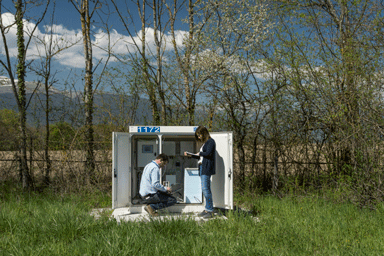Les rayonnements au CERN
CERN, the European Organization for Nuclear Research, is a laboratory that studies particles and their interactions, but is not concerned with nuclear energy or weaponry. The name is derived from European Council for Nuclear Research, a provisional body founded in 1952 with the mandate of establishing a world-class fundamental physics research organization in Europe. At that time, pure physics research concentrated on understanding the inside of the atomic nucleus and the word ‘nuclear’ in the name reflects this. Very soon, the work at the laboratory went beyond the study of the atomic nucleus and onto sub-nuclear particles and their interactions. With the exploration of sub-nuclear scales, the field of research was renamed “particle physics” which describes more accurately the current work at CERN, even though the Laboratory kept its original name and acronym.
Nuclear power plants produce electricity from the heat released in nuclear chain reactions. CERN is not operating a nuclear reactor and it has only negligible amounts of fissile material, therefore no chain reaction can be sustained at CERN. The reactions studied at CERN are initiated by particle beams and cannot lead to a chain reaction.
Ionizing radiation is energy that is transported through particles or waves, such as electromagnetic radiation (X-rays, gamma rays), neutrons, etc. It occurs, for example, when unstable atoms decay to form stable atoms, and release some of their energy. Rocks, the Sun and Space all naturally emit ionizing radiation that we can detect on Earth. Artificial ionizing radiation also comes from medical examinations and treatments or in small amounts through mining. Though safe in small doses, in high doses ionizing radiation can be dangerous as the energy can knock electrons off the atoms of living bodies, ionizing and damaging them. The ionizing radiation dose is usually measured in Sieverts (Sv), which is a measure of the health effect of radiation on the body.
CERN’s experiments involve colliding particles beams together or into a stationary target. When this happens some of the particles release radiation or new particles are created. Radiation only occurs at CERN when the particle beam is on, and turning it off stops the emissions immediately. Collision events are also very rare; at the Large Hadron Collider only 1 nanogram (one millionth of a milligram) of protons are accelerated in a day and only a small proportion of these collide. It would in fact take millions years to collide 1 gram of protons. Radiation is sometimes causing some of the components surrounding the collision points to become radioactive. These components are well confined, their handling rigorously controlled and when the accelerator is dismantled they are handled following the appropriate regulations and standards.
The majority of the radiation produced by particle collisions is absorbed by the accelerator components. The majority of the radionuclides have short half-lives, the typical half-life being 5.3 years. This means that they are radioactive for only a very short time. Within the CERN facilities the radiation is dealt with following the appropriate radiation protection regulations and standards. The air used for the ventilation and the water used for the cooling of the accelerators can contain small amounts of radioactive elements. All the necessary actions are taken to prevent these from reaching the environment.
The effective doses to members of the public living closest to CERN and attributed to CERN facilities are so low that they are almost impossible to measure. People living near CERN’s sites receive a maximum annual dose in the range 0.01-0.02 millisieverts, less than 1% of the annual dose received from other sources such as cosmic rays, radon and medical examinations. For example, the average annual dose of radiation in Switzerland is 5.6 milliSieverts (including e.g. contributions from medical activities and plane travels) and in France is 3.7 millisieverts (including e.g. contributions from medical activities and plane travels).
The Swiss Federal Office of Public Health (OFSP) and the French Institute of Radiation protection and Nuclear Safety (IRSN) have both stated that compared to these natural fluctuations, the effect of CERN’s radiation on the public is negligible. This additional dose from CERN is also lower than natural differences between different areas, so that moving between municipalities has a greater effect on annual radiation dose than living near CERN.

CERN adheres to an internationally recognised radiation protection system that continuously strives to minimize radiation exposure and, consequently, CERN’s emissions remain consistently well below regulatory limits.
CERN’s radiation protection team surveys the ionising radiation produced inside the facilities and close to the facilities. Alarmed gate-monitors are installed and managed by CERN’s radiation protection team to prevent the uncontrolled export and import of radioactive materials. The CERN Safety & Environment teams take samples of ambient air, soil, river water, groundwater, rainwater, vegetation and agricultural products from the surrounding environment, and carry out thousands of analyses on these samples every year.
CERN imposes limits on the exposure of staff and visitors according to EU law. All of CERN’s personnel working in sensitive areas is monitored by the Dosimetry Service of CERN’s radiation protection group, which is accredited by Switzerland. The Service distributes dosimeters that measure the exposure of each worker to ionizing radiation. CERN is very committed to ALARA implying a state-of-the-art job and dose planning for works in CERN’s radiation areas aiming to minimise the dose to the workers.
Since the LHC experiments are underground, this provides a natural barrier to radiation. CERN’s radiation protection team generates computer simulations of the radiation fields of existing and planned facilities, such as the LHC, to anticipate any problems ahead of time. In this way, CERN predicts and minimizes its environmental impact before any facilities are constructed.
